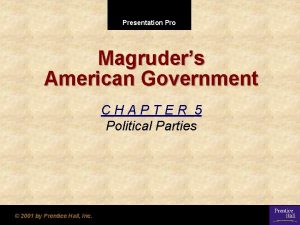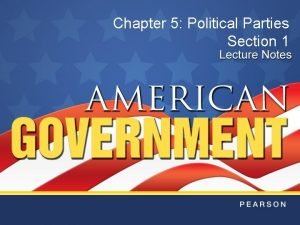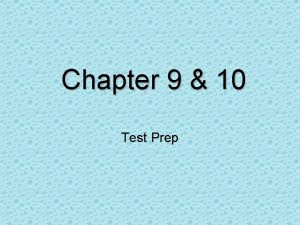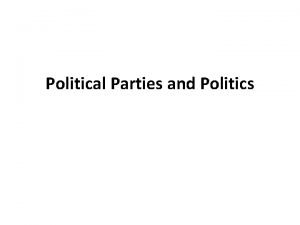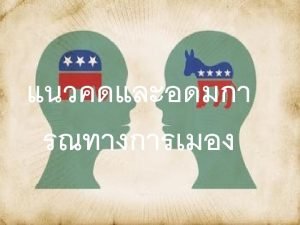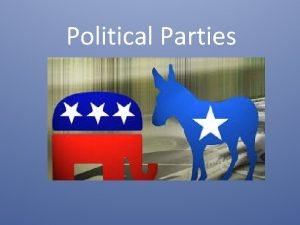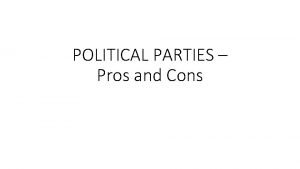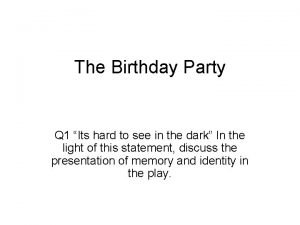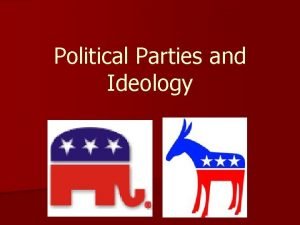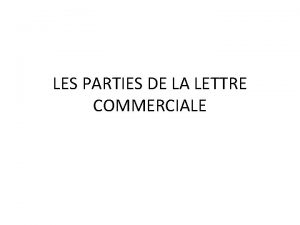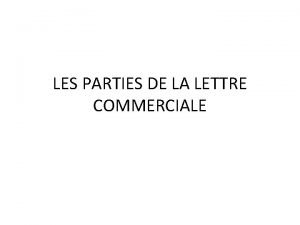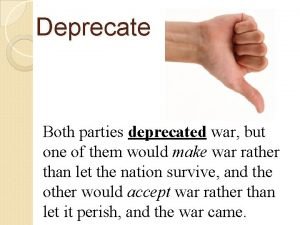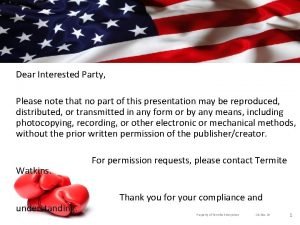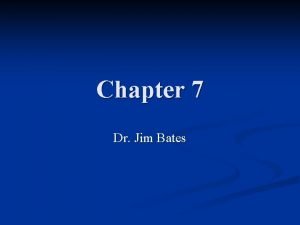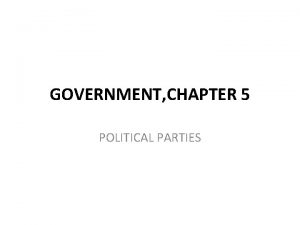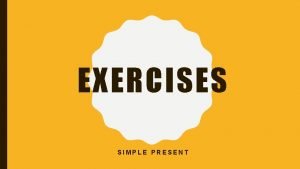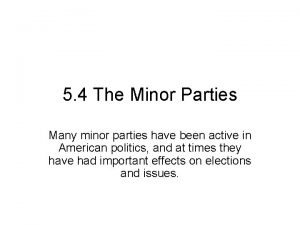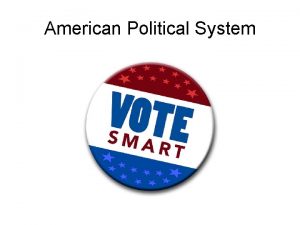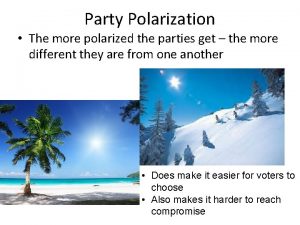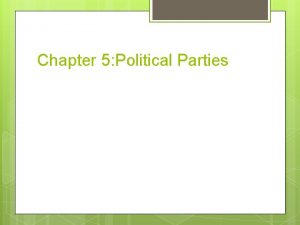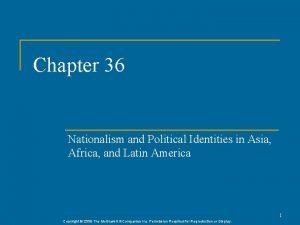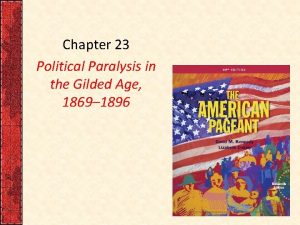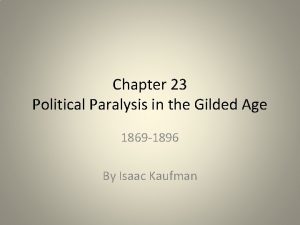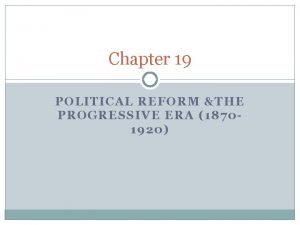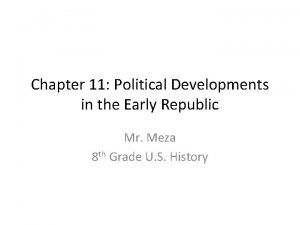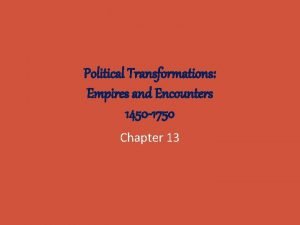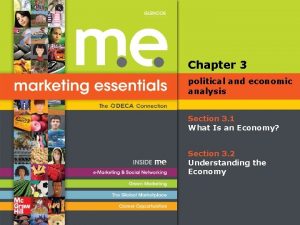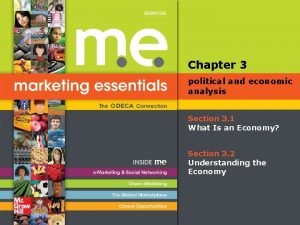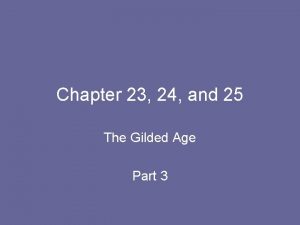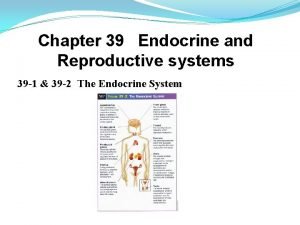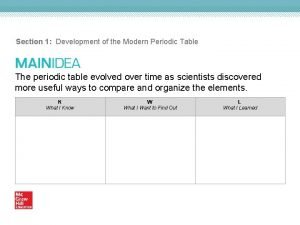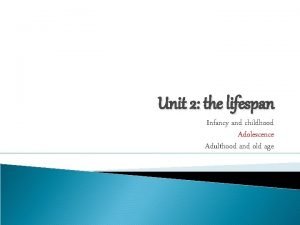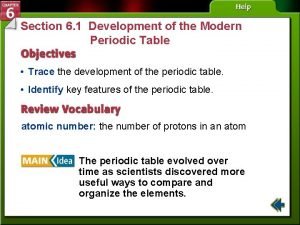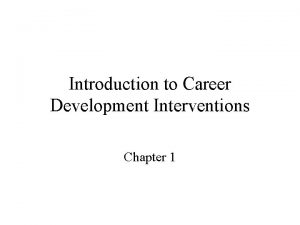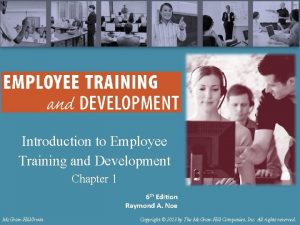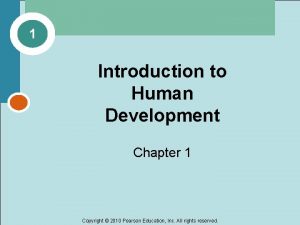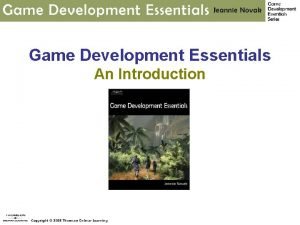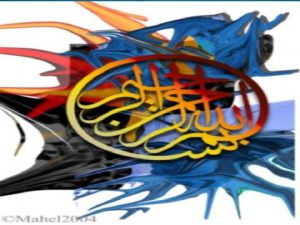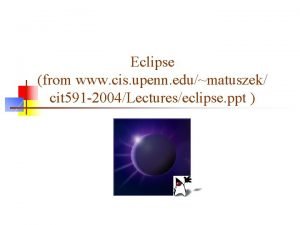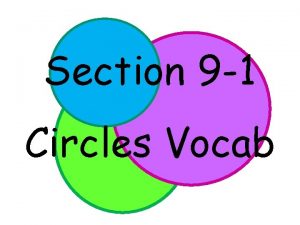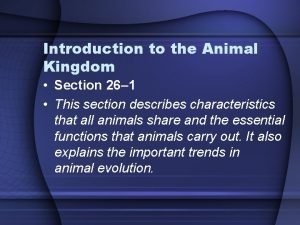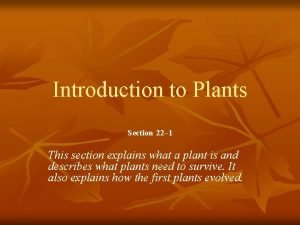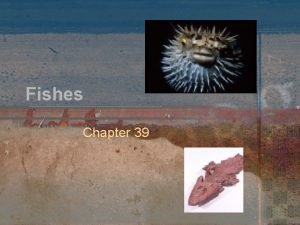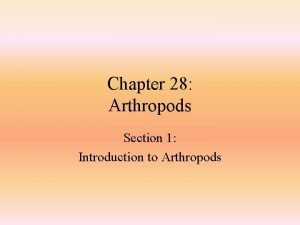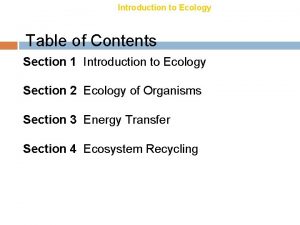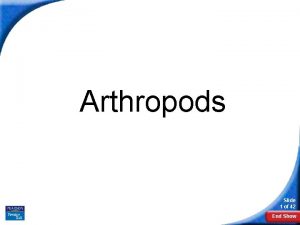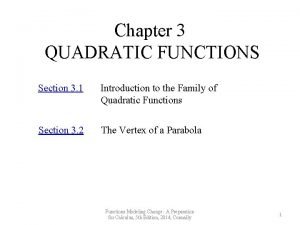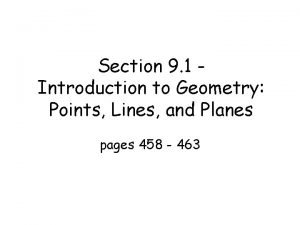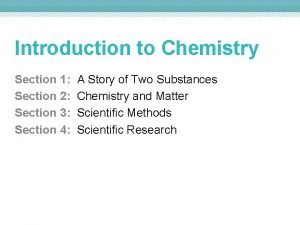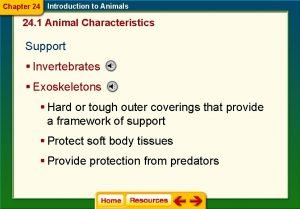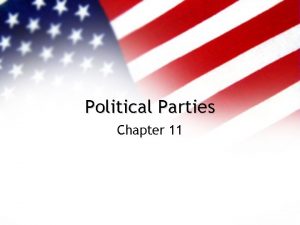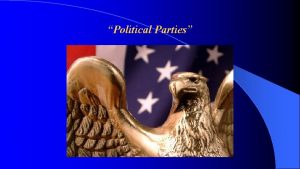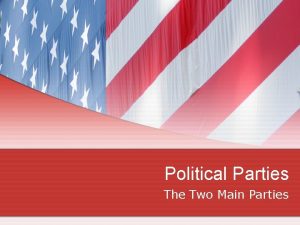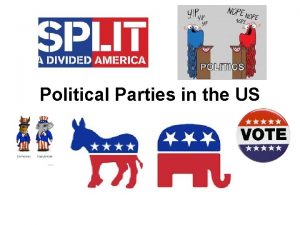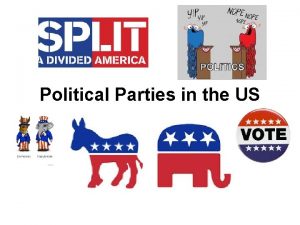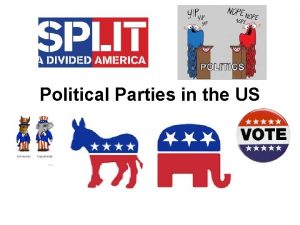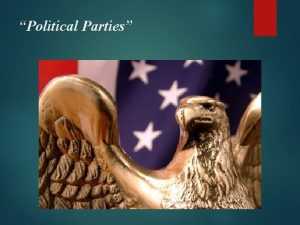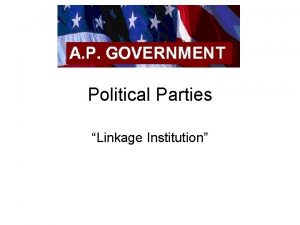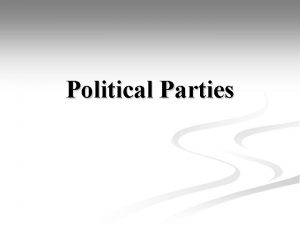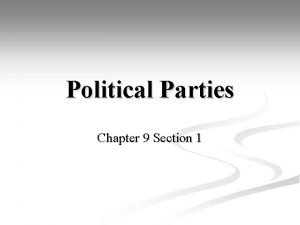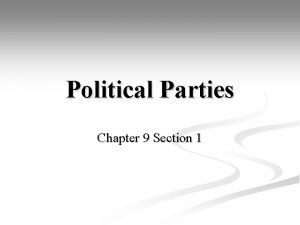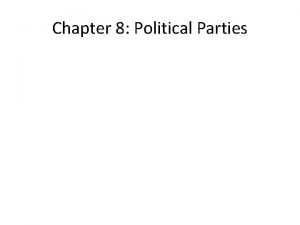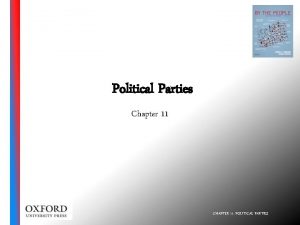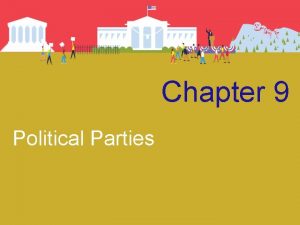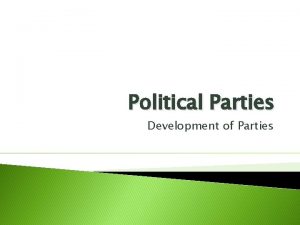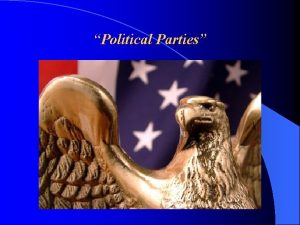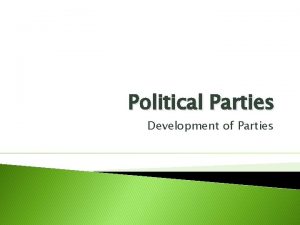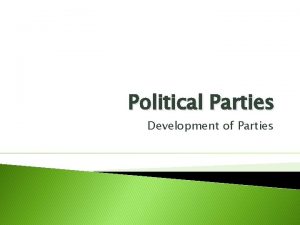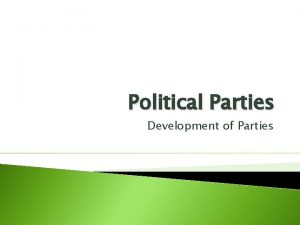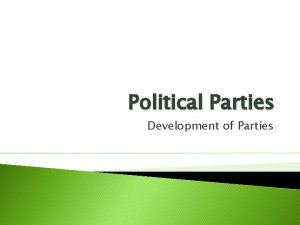Chapter Introduction Section 1 Development of Political Parties


















































































- Slides: 82


Chapter Introduction Section 1: Development of Political Parties Section 2: Role of Political Parties Today Visual Summary

The Constitution makes no mention of political parties, but the first ones formed during the early years of the republic. Today, the United States has several political parties, although two—the Democrats and the Republicans— dominate American politics.

Section 1: Development of Political Parties Political and economic institutions evolve to help individuals and groups accomplish their goals. The United States had a twoparty system since its early days as a nation.

Section 2: Role of Political Parties Today Political and economic institutions evolve to help individuals and groups accomplish their goals. Political parties play a large role in the decisions made by government.


Guide to Reading Big Idea Political and economic institutions evolve to help individuals and groups accomplish their goals.

Guide to Reading Content Vocabulary • political party • platform • two-party system • plank • third party Academic Vocabulary • stress • promote

• Which leader warned that political parties may have harmful effects? • Federalist believed that the best way to protect individual rights was to have; • Which of the following is an example of a single-issue party?

• By reading a party platform, you can learn about the party’s … • Thomas Jefferson believed that strong state governments would protect individual rights better than a strong national government because the states are …

• A breakaway group of Democrats and Whigs formed the Republican Party in 1854 because they tended to: • In the United States, third parties are called minor parties because they … • What countries are governed by a one party system?

Political Parties Political parties play a vital role in our democratic system. • Political parties form to win elections and influence government. • Historically, the United States has been dominated by a two-party system. • Washington’s warning against forming political parties

Political Parties (cont. ) • Jefferson and Hamilton’s differing viewpoints: – Jefferson supported limited federal government – Hamilton believed individual rights called for a strong national government

Political Parties (cont. ) • Jefferson and the Democratic-Republican Party opposing Hamilton and the Federalist Party, early 1800's • Democratic-Republican Party split by 1828 • Democratic Party then competing with the Whig Party Evolution of American Political Parties

Political Parties (cont. ) • Formation of the Republican Party, 1854 • Abraham Lincoln is first Republican president Evolution of American Political Parties

Third Parties Throughout American history, additional parties have arisen to influence politics. • Third parties have competed in the nation’s two-party system. • Populist Party called for direct election of senators and eight-hour working day

Third Parties (cont. ) • Progressive Party ideas: – The direct primary – The initiative – The referendum Leading Third-Party Presidential Candidates, 1948– 2004

Third Parties (cont. ) • Single-Issue parties: – Promote a social, economic, or moral issue – Prohibitionist Party formed to ban alcohol – Usually do not last long Leading Third-Party Presidential Candidates, 1948– 2004

Third Parties (cont. ) • Ideological parties: – Support a set of beliefs or political doctrine – Socialist Labor Party, Communist Party USA, and the Libertarian Party as examples Leading Third-Party Presidential Candidates, 1948– 2004

Third Parties (cont. ) • Third parties forming around independent candidates • Two-party tradition and raising money as obstacles to third parties Leading Third-Party Presidential Candidates, 1948– 2004

Third Parties (cont. ) • Political parties in other countries • Multiparty system: – Three or more parties compete for control of government – Parties often must work together – Politically unstable because of competing interests

Third Parties (cont. ) • One-party system – Party and government nearly the same thing – Elections as empty exercise

How the Parties Differ Political parties play a large role in the decisions made by government. • Republicans and Democrats largely differ on the way that government should be involved in the lives of Americans. • Adoption of moderate and mainstream positions • Party platform made up of planks


Guide to Reading Big Idea Political and economic institutions evolve to help individuals and groups accomplish their goals.

Guide to Reading Content Vocabulary • national committee • caucus • precinct • ward • political machine • direct primary • closed primary • open primary • plurality • majority • petition

Guide to Reading Academic Vocabulary • range • adjacent

• Which group writes a party’s platform at its national convention? • What is the main event at a national party convention? • The role of a party committee at the county level is to: • What role is a party member playing when he or she tells leaders about concerns neighbors have?

• How does a candidate who Is not a Democrat or Republican get her name on the ballot for a general election? • What is the job description for the chairperson of a national committee? • What is the purpose of a Congressional campaign committee?

• Which political committee would be most likely to focus on electing party candidates to the position of governor? • To win a primary election in most states, the candidate must receive a • The purpose of the watchdog role is to:

Organization of Political Parties Democrats and Republicans are organized into 50 state parties and thousands of local parties that operate independently of the national organization.

Organization of Political Parties (cont. ) • The two major parties are organized at the local, state, and national levels. Organization of Political Parties

Organization of Political Parties (cont. ) • The national committee of each party: – Made of representatives from every state – Raises funds for presidential elections – Organizes the party’s national convention – Run by a national party chairperson Organization of Political Parties

Organization of Political Parties (cont. ) • National Convention: – Held once every four years – Party delegates nominate candidates for president and vice president Organization of Political Parties

Organization of Political Parties (cont. ) • Party delegates: – Chosen through presidential primary elections and caucuses – Write the party platform Organization of Political Parties

Organization of Political Parties (cont. ) • Campaign committees: – Made of members of Congress – Help elect party members and raise money Organization of Political Parties

Organization of Political Parties (cont. ) • State organizations of a party: – Focus on electing party candidates to state offices – Work to elect party candidates for national offices • Local organizations of a party consisting of city, town, and county committees Organization of Political Parties

Organization of Political Parties (cont. ) • Precinct: – Geographic area containing a specific number of voters – Voters cast ballots at the same place – Run by precinct captains – Several geographically-connected precincts make up a ward Organization of Political Parties

Organization of Political Parties (cont. ) • County committees: – Counties are the largest political units within a state – County chairperson has political power – Precinct and ward leaders building the party at the “grassroots” level Organization of Political Parties

Organization of Political Parties (cont. ) • Political machines: – Strong local party organizations – New York City’s Tammany Hall and “Boss” Tweed – Political machines serving useful purpose in the past – Political machines considered harmful today Organization of Political Parties

Nominating Candidates Political parties nominate candidates to run for public office.

Nominating Candidates (cont. ) • Political parties hold primaries to nominate candidates for office • Direct primary: – Voters chose candidates to represent each party in a general election – Two main forms are closed and open primaries

Nominating Candidates (cont. ) • Only declared members of a party allowed to vote for party’s nominee in a closed primary • Voters need not declare their party preference to vote for party’s nominee in an open primary • Arguments for and against the closed primary

Nominating Candidates (cont. ) • Winning a primary: – Plurality of votes – Majority of votes – Winner becomes party candidate in the general election • Unaffiliated candidates added to ballots by petition

Other Party Roles In addition to nominating candidates for office, political parties have many other responsibilities.

Other Party Roles (cont. ) • Political parties perform many functions that allow citizens to communicate with the government.

Other Party Roles (cont. ) • Functions of political parties: – Campaigning for candidates – Informing citizens – Carrying the people’s message – Operating the government – Acting as a watchdog – Linking the different levels of government


What Is a Political Party? • A political party is a group of individuals outside of government that organizes to win elections, to operate the government, and to determine policy.

Political Parties Form • Shortly after our nation began, two political parties formed. • The basic difference between the two parties today is their beliefs in how much the government should be involved in Americans’ lives. • In the United States, we have a two-party system, which means that two major parties—the Democrats and the Republicans—dominate national politics.

Organization • Each party has a national committee and congressional campaign committees. Each party also has 50 state committees and many local party organizations. • In the past, some local party organizations became so powerful that their candidates won almost every election. These were known as political machines.

What Political Parties Do • Select candidates • Inform the public • Coordinate policy making • Balance competing interests • Run campaigns

Comparing Parties • One way to compare political parties is to study their party platforms, which are declarations of each party’s beliefs and positions on major issues. • The platform is made of planks, which are the party’s official positions on specific issues such as education, crime, and foreign policy.






a democrat


political party an association of voters with broad common interests who want to influence or control decision making in government by electing the party’s candidates to public office

two-party system a system of government in which two parties compete for power

third party a party that challenges the two major parties

platform a series of statements expressing the party’s principles, beliefs, and positions on election issues

plank each individual part of a political party’s platform

stress to place special importance or emphasis on something

promote to encourage the acceptance or recognition of

national committee representatives from the 50 state party organizations who run a political party

caucus a meeting of political party members to conduct party business

precinct a geographic area that contains a specific number of voters

ward several adjoining precincts making up a larger election unit

political machine a strong party organization that can control political appointments and deliver votes

direct primary an election in which voters choose candidates to represent each party in a general election

closed primary an election in which only the declared members of a party are allowed to vote for that party’s nominees

open primary an election in which voters need not declare their party preference to vote for the party’s nominees

plurality the most votes among all those running for a political office

majority a number that is more than 50 percent of the total

petition a formal request for governmental action; a process by which candidates who are not affiliated with one of the two major parties can get on the ballot for the general election in most states

range a variation between limits

adjacent neighboring or near

To use this Presentation Plus! product: Click the Forward button to go to the next slide. Click the Previous button to return to the previous slide. Click the Home button to return to the Chapter Menu. Click the Transparency button from the Chapter Menu or Chapter Introduction slides to access the TIME Transparency that is relevant to this chapter. From within a section, click on this button to access the relevant Daily Focus Skills Transparency. Click the Return button in a feature to return to the main presentation. Click the Economics Online button to access online textbook features. Click the Reference Atlas button to access the Interactive Reference Atlas. Click the Exit button or press the Escape key [Esc] to end the chapter slide show. Click the Help button to access this screen. Links to Presentation Plus! features such as Graphs in Motion, Charts in Motion, and figures from your textbook are located at the bottom of relevant screens.

This slide is intentionally blank.
 Chapter 5 the minor parties
Chapter 5 the minor parties Chapter 5 section 1 parties and what they do
Chapter 5 section 1 parties and what they do Chapter 5 section 1 parties and what they do
Chapter 5 section 1 parties and what they do Brainpop voting
Brainpop voting What was one way progressives differed from populists
What was one way progressives differed from populists Political parties
Political parties The supreme court change
The supreme court change A political party is an association of
A political party is an association of Sistemas democraticos
Sistemas democraticos Political parties
Political parties Political parties pros and cons
Political parties pros and cons Ovulation animation
Ovulation animation Chapter 10 section 1 meiosis worksheet answer key
Chapter 10 section 1 meiosis worksheet answer key Topic sentence for birthday parties
Topic sentence for birthday parties Self-announcement definition
Self-announcement definition Food feast
Food feast Les différentes parties de la lettre commerciale
Les différentes parties de la lettre commerciale Les parties de la lettre
Les parties de la lettre Race de dauphin
Race de dauphin Iso 14001 risk and opportunities examples
Iso 14001 risk and opportunities examples Deprecate in a sentence
Deprecate in a sentence Dear interested
Dear interested Microscope optique
Microscope optique Why is myrtle wilson upset when she sees tom and jordan
Why is myrtle wilson upset when she sees tom and jordan Economic protest parties definition
Economic protest parties definition Sarah and pam often go to parties
Sarah and pam often go to parties Plan de texte narratif
Plan de texte narratif Accounting information system chapter 1
Accounting information system chapter 1 Economic protest parties
Economic protest parties Socialist parties
Socialist parties Texte argumentatif secondaire 5
Texte argumentatif secondaire 5 Paries caroticus tympani
Paries caroticus tympani Comparaison entre cellule animale et végétale
Comparaison entre cellule animale et végétale Why did gatsby throw parties
Why did gatsby throw parties Power point parties
Power point parties Horses hate surprise parties
Horses hate surprise parties Innovator role of minor parties
Innovator role of minor parties Gaines techniques parties communes
Gaines techniques parties communes Splinter parties definition
Splinter parties definition Chapter 19 protists worksheet answers
Chapter 19 protists worksheet answers The study of life section 1 introduction to biology
The study of life section 1 introduction to biology Chapter 35 nationalism and political identities in asia
Chapter 35 nationalism and political identities in asia Chapter 36 nationalism and political identities in asia
Chapter 36 nationalism and political identities in asia Chapter 23 political paralysis in the gilded age
Chapter 23 political paralysis in the gilded age Chapter 23 political paralysis in the gilded age
Chapter 23 political paralysis in the gilded age Chapter 19 political reform and the progressive era
Chapter 19 political reform and the progressive era Chapter 11 political developments in the early republic
Chapter 11 political developments in the early republic Chapter 5 political transformations empires and encounters
Chapter 5 political transformations empires and encounters Chapter 3 political and economic analysis
Chapter 3 political and economic analysis Chapter 3 political and economic analysis
Chapter 3 political and economic analysis Chapter 23 political paralysis in the gilded age
Chapter 23 political paralysis in the gilded age Historical background of community development
Historical background of community development Development that ended much development crossword
Development that ended much development crossword The development of an object that is rolled or folded
The development of an object that is rolled or folded Section 39-4 fertilization and development
Section 39-4 fertilization and development Section 1 development of the modern periodic table
Section 1 development of the modern periodic table Lesson quiz 4-2 adolescence answer key
Lesson quiz 4-2 adolescence answer key Section 6.1 development of the modern periodic table
Section 6.1 development of the modern periodic table Revolve section view
Revolve section view Removed section drawing
Removed section drawing What is full section?
What is full section? Describing energy section 2 answers
Describing energy section 2 answers Misconceptions about career assessment
Misconceptions about career assessment Introduction to android development
Introduction to android development Physical development
Physical development Introduction to employee training and development
Introduction to employee training and development Nature of human development
Nature of human development Game development essentials an introduction
Game development essentials an introduction Process adopted for curriculum development in pakistan
Process adopted for curriculum development in pakistan Cit 591 introduction to software development
Cit 591 introduction to software development Section 9 topic 1 introduction to circles
Section 9 topic 1 introduction to circles Section 26-1 introduction to the animal kingdom
Section 26-1 introduction to the animal kingdom Section 22-1 introduction to plants answer key
Section 22-1 introduction to plants answer key Section 32-2 diversity of mammals
Section 32-2 diversity of mammals Section 28-2 groups of arthropods
Section 28-2 groups of arthropods Section 39-2 review jawless and cartilaginous fishes
Section 39-2 review jawless and cartilaginous fishes Chapter 28: arthropods worksheet answers
Chapter 28: arthropods worksheet answers Section 18-1 introduction to ecology worksheet answers
Section 18-1 introduction to ecology worksheet answers Section 28-1 introduction to the arthropods
Section 28-1 introduction to the arthropods Section 3 introduction to functions
Section 3 introduction to functions Section 1 introduction to geometry answers
Section 1 introduction to geometry answers Introduction to chemistry section 3 scientific methods
Introduction to chemistry section 3 scientific methods Introduction to animals section 1 animal characteristics
Introduction to animals section 1 animal characteristics

